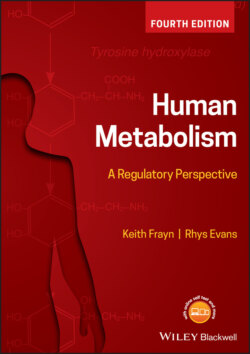Читать книгу Human Metabolism - Keith N. Frayn - Страница 14
1.2 The chemistry of food – and of bodies
ОглавлениеEnergy is taken into the body in the form of food. The components of food may be classified as macronutrients and micronutrients. Macronutrients are those components present in a typical serving in amounts of grams rather than milligrams or less. They are the well-known carbohydrate, fat, and protein. Water is another important component of many foods, although it is not usually considered a nutrient. Micronutrients are vitamins, minerals, and nucleic acids: they are not oxidised to provide energy, but rather they are used to facilitate biochemical mechanisms of the body. Although these micronutrients play vital roles in the metabolism of the macronutrients, they will not be discussed in any detail in this book, which is concerned with the broader aspects of what is often called energy metabolism.
The links between nutrition and energy metabolism are very close. We eat carbohydrates, fats, and proteins. Within the body these relatively large molecules are broken down to smaller components, rearranged, stored, released from stores, and further metabolised, but essentially whether we are discussing food or metabolism the same categories of carbohydrate, fat, and protein can be distinguished. This is not surprising since our food itself is of organic origin, whether plant or animal.
In order to understand metabolism and metabolic regulation, it is useful to have a clear idea of some of the major chemical properties of these components. This is not intended as a treatise in physical or organic chemistry but as a starting point for understanding some of the underlying principles of metabolism. The discussion assumes a basic understanding of the meaning of atoms and molecules, of chemical reactions and catalysis, and some understanding of chemical bonds (particularly the distinction between ionic and covalent bonding).
